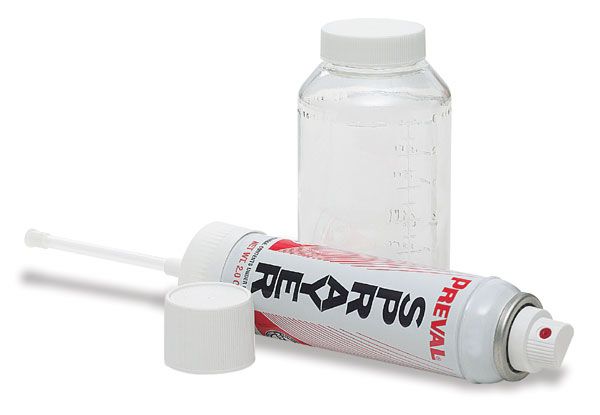Few used sailboats are without some minor gel coat repairs that need attending. The small spidercracks and chips may seem like an easy job, but there is a bit of art involved. And it is also important to keep in mind that areas where several cracks are concentrated might indicate more significant concerns below the surface (wet deck core being a common cause).
The following report is for smaller blemishes that generally come with age, or result from a small impacts (an errant winch handle or anchor are common culprits). If you’re dealing with major repairs or fairing projects, our reports on fairing and filling includes a comprehensive look at pre-thickened epoxy fairing compounds, and two-part epoxies that you thicken by adding microballoons or other thickening agents. For these smaller dings, you could use another product we’ve reviewed, Magic Fix, but the Preval Sprayer combined with color-matched gelcoat described below is a better way to deal with larger dings, and can be used in combinations with fill-and-fair repairs.
Past PS articles have described how professional gelcoat repairs could be made with an inexpensive hobby-type airbrush called the Badger #250-1 Basic Spray Gun, a widely available tool that is popular among hobbyists. As good a job as the Badger does, however, setting up and cleaning the tool is a multi-step process. In the interest of simplicity, we have also outlined an alternative method of repairing gelcoat—applying gelcoat with a brush instead of with a spray gun.
The advantage of “painting” gelcoat on is that you save the $17 price of an airbrush and the hassle of setup and cleanup. However, you can’t finish the job in one sitting; the gelcoat must be brushed on in several coats to achieve good coverage.
Fortunately there is a less expensive product that can deliver professional results, the Preval Sprayer. The Preval combines the best of the Badger and the paint brush. It’s quick to set up and clean, and provides adequate coverage in a single application. Best of all, it’s available in auto supply stores and hardware for just $7, so when you are done with it, you can just throw it away.
The Preval Sprayer is not a new product. It has been used for many years by boatbuilders and boatyards to do spot repairs to gelcoat. It’s not economical even for a yard to do minor cosmetic repairs with a big, compressor-driven industrial spray gun. Not only is the setup and cleanup time-consuming, but large spray guns require a relatively large quantity of gelcoat to operate, which is wasteful when doing touch-up work. For an extra $3, the Preval comes with its own 16-ounce paint jar that screws onto the base of the propellant can. However, we don’t recommend buying the paint jar. It is too big for gelcoat work, as it requires nearly 2 ounces of liquid to keep the stem of the propellant can immersed. This is 2 ounces that you cannot afford to waste.
Instead, use an unwaxed paper cup. Just stick the stem of the propellant can in a corner of the cup as you spray. You must be careful to keep the stem immersed in gelcoat, or the sprayer will sputter and splatter. You must also be careful not to tilt the propellant can more than 60 degrees, or the spray will come out in large droplets. As long as these two precautions are followed, the Preval appears to do just as good a job as the more expensive and time-consuming Badger Air Brush.
The Preval will spray 16 ounces of liquid with a full can of propellant. This means you can re-use it for several gelcoat repairs before you toss it.
However, you must carefully clean it after every use. Cleaning is a quick three-step procedure: First, stick the stem in acetone and spray for a few seconds. Then clean the strainer on the bottom of the stem by inverting the propellant can, putting your finger over the spray button orifice to create back pressure, and give it a few quick bursts.
As a final precaution, stick the stem back in acetone and spray it through the system for a few more seconds. When buying gelcoat, it’s best to check first with the builder of your boat, because he is most likely to have colors that match, or give you the information you need to make a match. Mini-craft of Florida offers an extensive supply of gelcoats and pigments, as well as its own color-matching service. You can also find pigments at retailers like West Marine, Defender, or Jamestown Distributors or your local boatyard. Be aware that some of the so-called “gelcoat repair kits” sold at retailers are not formulated in the same way as your original gelcoat, and will not deliver the same finish. Mini-craft or a local fiberglass supply house is a better source.
As with any gelcoat job, the surface must be perfectly faired with auto body and/or lacquer putty, or fairing compound before spraying. The gelcoat must be thinned slightly with reducer to spray evenly (although acetone is often recommended from thinning, it will cause the finish to more quickly lose its brightness, color, and gloss). You can’t forget to coat the wet gelcoat with PVA (polyvinyl alcohol) or it won’t dry tackfrede. PVA is available from Evercoat and others and is easily sprayed over your repair with the Preval. It cleans with water. After the gelcoat is dry, you must sand it with 260-grit wet/dry paper, then with 400 and 600 grit, and finally, buff it with polishing compound.
For more on gelcoat repair and fixing just about anything else on your old boat, Don Caseys “This Old Boat,” is a great resource. And my recent blog post on fiberglass polishing links to various Practical Sailor tests of articles on cleaning, protect, and maintain gelcoat.





































These cracks and weakening of the structures also seem to occur around the vertical stantions, especially in the stern on the transom where people enter the boat, using the convenient rails to pull themselves aboard.
Also problematic are the huge number of “idiots” that insist on uselessly fending off by pushing on the stantions and rails instead of sitting down and using their legs so much more effectively against the hull or toe rails of the other boat.
I am starting to have reinforcement plates made to measure in 316 SS for the transom stantions through the edge of the deck. It can be done quite neatly and should prevent the aggravation of what is already clearly micro cracking.
As for the ‘Idiots’ I regret that unfortunately they will always be around, the same ones that leave their berths without informing the marina or checking for traffic, and do so with their VHFs off and their horseblinders on.
What the heck, life is still too good to fret over a few fools….
Buyers should consider vessels like our Swan41 , not crack in the hull or deck. No plywood or foam in the hull or deck. Over 800 S&S Swans were made. 95% are still sailing and they have not built one in over forty years
RAy
Will the Preval sprayer work on crazing cracks or will it glob on too much gelcoat to make that application impractical?
Steel over 100 yr.